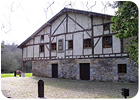
photo by Jennifer Adams
Located just several miles from the city of San Sebastián in Spain's Basque country is Chillida-Leku -- a sculpture museum paying tribute to the work of one of the great 21st-century sculptors, Eduardo Chillida. But this museum, which sits within a forest filled with Oak and Beech trees, varies drastically from typical art institutions. Large sculptural works -- made of materials such as marble, granite and Corten steel -- stretch high into the sky and are displayed throughout the sprawling grounds. And while these works are intriguing and awe-inspiring enough, another attraction on the site is a 16th-century stone farmhouse, which the artist restored himself and which houses its own collection of artwork.
Chillida-Leku was a life-long dream of Chillida, whose work is displayed in museums around the world. "One day I dreamt of utopia -- to find a space where my sculptures could rest and where people could walk among them as if walking through the woods," he stated in a quote appearing in a book entitled Museo Chillida Leku. He and his family, which includes his wife Pilar Belzunce and eight children, spent many years searching for just the right spot to bring his dream to fruition.
In 1984, the Chillida family purchased the first parcel of the Zabalaga estate, which means "big field." Chillida and his wife had visited the property as guests in the early 1980s, and they immediately fell in love with it. Along with the first parcel of land, they also purchased the farmhouse, which was built in 1543 and is considered to be one of the oldest buildings still standing in Gipuzkoa. Over time, the family purchased additional sections of the property.
"We've turned the utopia into something concrete, and we've managed to do so with no outside funding, relying solely on our own effort and means," stated Pilar Belzunce in a quote from Museo Chillida Leku.
According to Chillida's son, the farmhouse was in poor condition and in desperate need of repair when it was first purchased. "My father worked with an architect from San Sebastián to restore it," he said, adding that it took more than a decade to revive the farmhouse piece by piece. "He restored all of the original stone. Some had to be moved and replaced."
The historic farmhouse became a labor of love for the sculptor. He treated it as another work of art. While the exterior stonework was restored to remain as true to the original as possible, the interior of the structure was completely gutted. Just as he did with his sculptures, Chillida gave careful consideration to planning how the inside of the farmhouse would be recreated.
It has been said that the sculptor would comment that he "talked" to the structure as he worked. "I would ask the house what it wanted to look like," stated a quote from Museo Chillida Leku. "As I walked through the interior, I would ask it if it wanted to keep this or that wall or floor, and the house turned out according to its own indications."
The final result is a warm, rustic-looking interior design that complements the exterior stonework, yet possesses a fresh charm and personality. Exposed fieldstone still comprises many of the walls, and handcrafted details such as a stone archway were implemented. Further contributing to the character of the farmhouse's interior are rough-hewn wooden beams that are secured to the ground with stone bases.
"The bases were taken from a church in San Sebastián that had been destroyed," explained Chillida's son. "My father found all of them."
All of the sculptor's hard work was rewarded in 1997, when the farmhouse restoration was completed. The inside of the two-story structure became a gallery to showcase some of his works -- including a collection of drawings from his early days as an artist.
"He was always looking for new materials," said Chillida's son about his father. "Different materials that he could think about and work."
Although Chillida passed away in 2002, his legacy lives on through his work and his family's dedication to maintaining Chillida-Leku. The sculpture garden as well as the historic farmhouse remain symbols of the sculptor's passion for art and serenity.